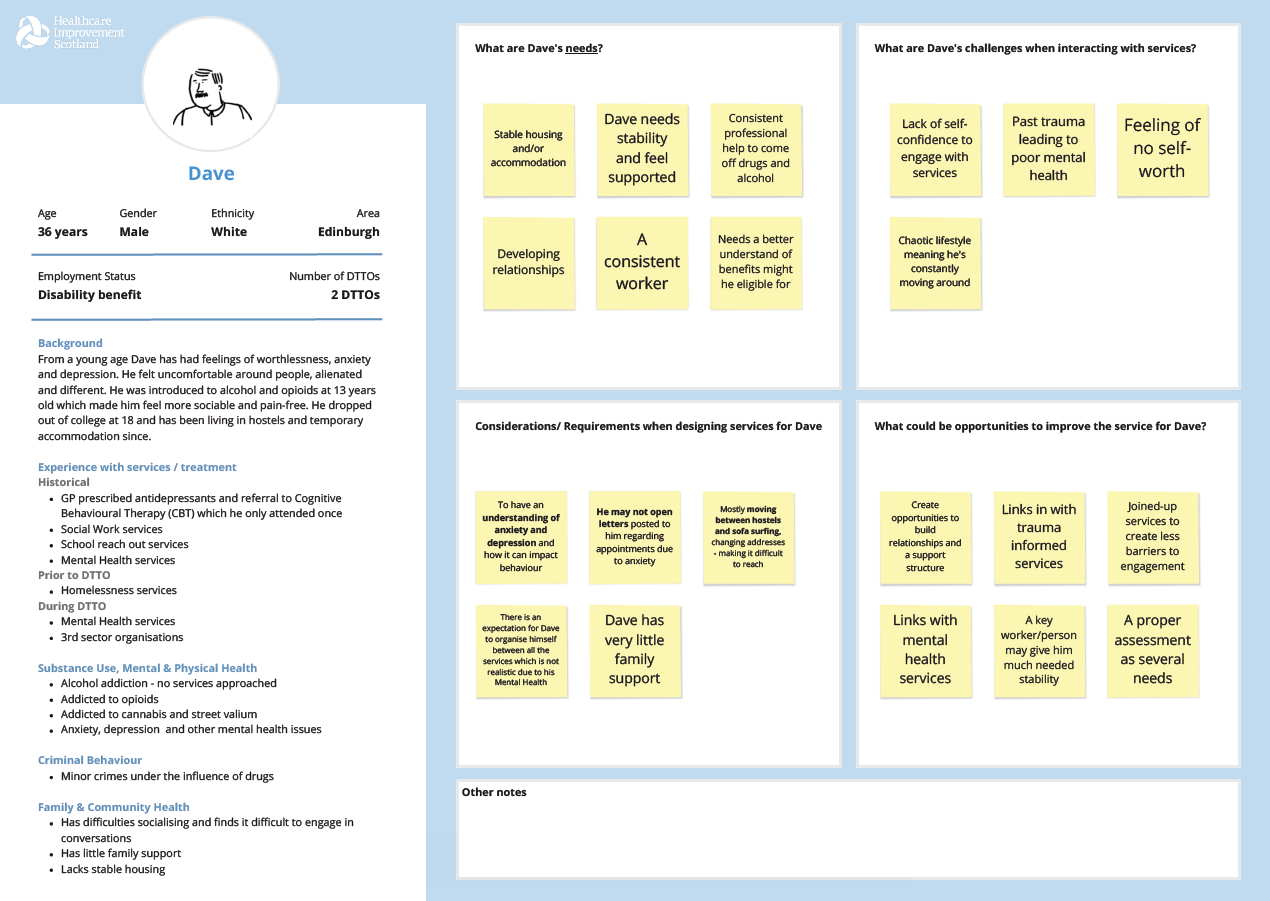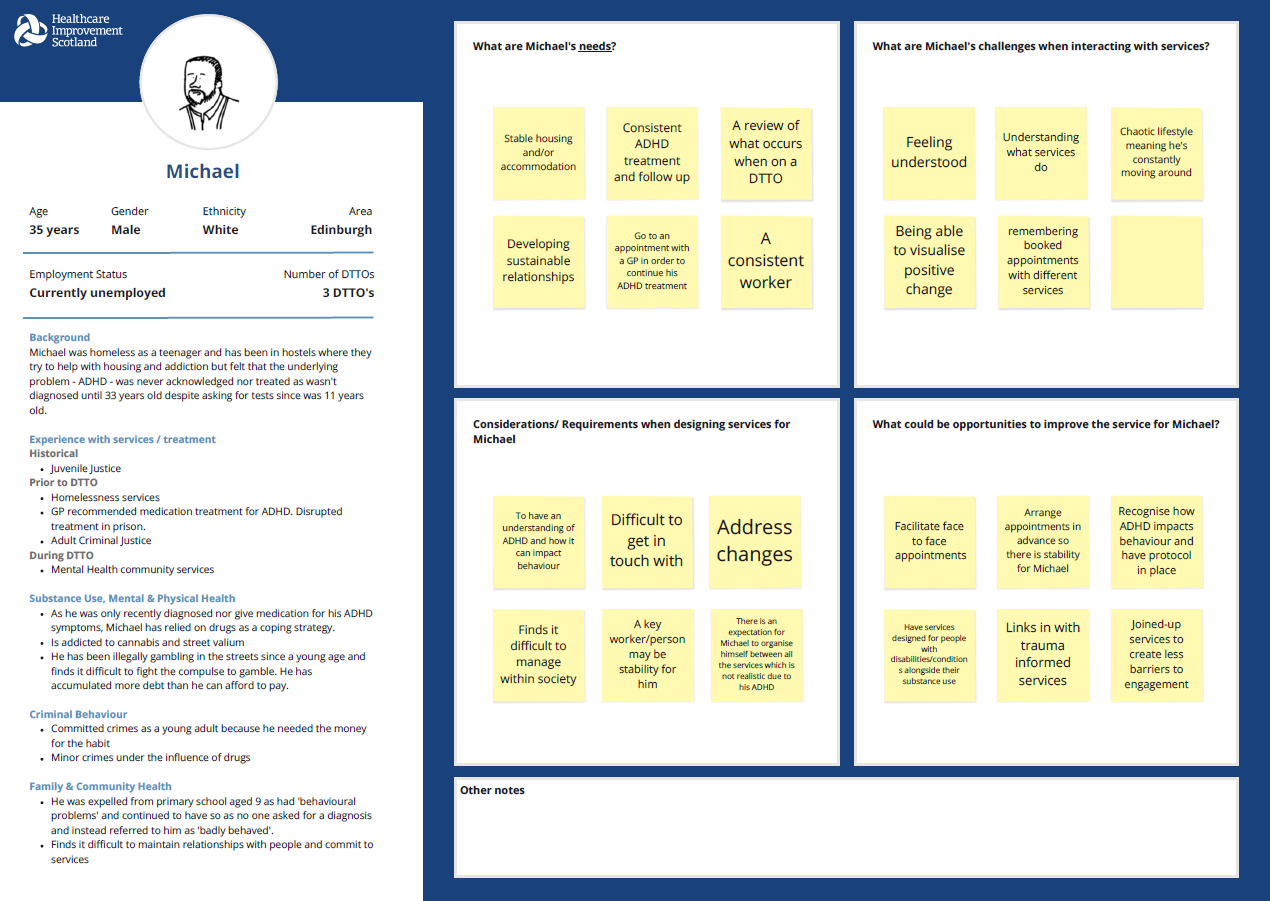Personas
About personas
Personas help your team consider the needs of people who seek support from services. It’s important to build Personas with multiple data sources to create ‘typical’ profiles. More data and checking will give you better results. Personas can include common experiences of service users. They can include their preferences, and the challenges they face. This aids services in the design of pathways that meet people’s needs.
Persona creation involves data:
- quantitative (service level), and
- qualitative (staff and service user feedback).
This can assist in identifying patterns, trends, and characteristics of service users. If this is your first time developing personas you may find it helpful ask advice from someone experienced in collecting and interpreting data. It is always important to explain how you developed the persona whenever you use them so that people don’t make assumptions.
The use of personas within teams and wider stakeholders can help you to:
- Understand the commonalities and challenges experienced by service users.
- Create services and practices that are inclusive.
- Reflect the diversity of those with co-occurring needs who access services.
- Consider what additional resources are needed.
- Generate change ideas to improve services.

Supporting your protocol development – how you might use this tool:
When looking at adapting and implementing a local protocol, this tool can:
- Further your understanding of the needs of this service user group.
- Identify commonly experienced challenges
- Consider good practice for people with co-occurring needs.
- Identify points in the system where people fall through the gaps.
Planning your workshop
You should develop personas as a group.
It may take several sessions after you have gathered evidence from a wide range of sources. The number of sessions needed will be dependent on that data that you use, and the number of people involved.
Several sessions will allow you to have enough time to create your personas. It will also enable time for reflection between sessions to inform the final outputs.
Preparing for the workshop
Click here for support on how to develop Personas.
- Data collection: Arrange a meeting with the person/persons responsible for service/service user data to obtain access. Conduct interviews with service users to obtain firsthand information and insight into lived experience of services and with service experts who have daily contact with service users.
- Using the data: It is best to use a combination of qualitative and quantitative data, from both clinical services and from lived experience feedback. When you have collected all your data, you will need to code your data to organise it. Tools such as Excel spreadsheets or Miro boards can be used to do this collaboratively. You will then need to triangulate your data. It is likely that the data collected will produce several personas. These should be sense checked with service experts, staff and people with lived experience.

What you need for the session
- Data
- Prompt questions
- Excel or Miro
Who should be involved
- Staff and service leads from mental health and substance use services.
- People with lived and living experience and wider stakeholders.
During the workshops
These sessions and work on persona development should not be done without the support and guidance of a service designer.
- Look for patterns in the data, what are the commonalities of people's experiences? There may be patterns relating to gender, psychological traits, general circumstances, difficulties experienced or personal goals. For example, if 50% of the people interviewed mention experiencing unemployment, half of the personas you create should include this.
- Workshops should develop personas further through facilitating in-depth conversations to gain more information such as psychological traits, substances used, what services can assist with specific challenges and what collaborative working could offer to improve people's experience of services and their personal circumstances.
- Focus on solution-based approaches. A tried and tested way to do this is to use your personas and have ideas generation around considerations and opportunities based on commonly cited needs and challenges (identified through your data and any previous workshops). This can be done in person using print outs of your personas and post it notes, or remotely using Miro or Jamboards.
Outputs and next steps
From this workshop you will be able to:
- Have a clear and accurate understanding of your service users.
- Share your personas with stakeholders or experts to ensure that they are accurate and useful.
- Use the personas for further engagement to develop ideas for improvement.
- The How Might We tool can be a useful next step in using personas to facilitate change

Check out the Service Design Tool Directory for more Service Design guidance and resources.
